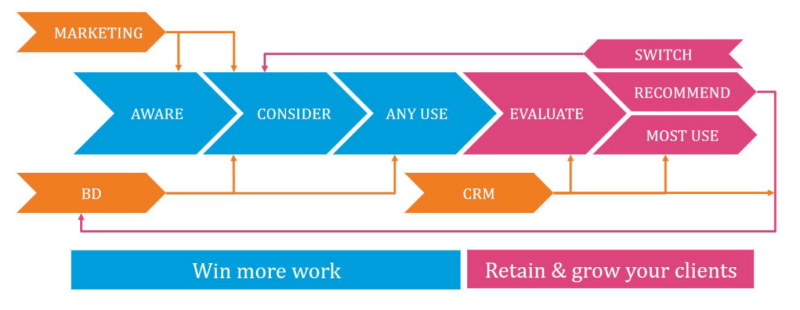Law firm leadership has understood for some time now that effective BD, marketing and external communications functions make a significant difference to their short- and long-term profitability.
Beaton has worked with leading firms on creating the most effective strategic marketing with a view to maximising their ROI. It is clear to us that understanding and execution are two very different things.
The recently released annual survey of Australian law firm leaders that Beaton conducts for CommBank confirms that ‘to position themselves for growth, firms are reporting that marketing and BD activities will be a key lever, which includes the hiring of marketing/BD staff but also training their practitioners in these skills’.
For the purposes of this article I group business development, client relationship management, marketing and external communication into the term strategic marketing. For further clarity, I also include pricing support and the collection of client feedback under strategic marketing.



The components of strategic marketing
Traditional Marketing (shortened to Marketing) in the graphic,
- The main purpose of marketing is driving awareness and consideration (i.e. at the top of the funnel) which are intended to communicate the firm’s points of difference, i.e. how it stands out from the competition and why it should be preferred
- This includes external communications (e.g. newsletter, social media), thought leadership, website, blog, articles in trade media
- Crucially all of these activities are delivered in media of various kinds, not in person by the people of the firm.
Business Development (BD) which is delivered in person, whether by partners / senior lawyers or specialist salespeople
- The main purpose of BD is driving trial (any use) and repeat use at the bottom of the funnel.
- In other industries BD is called sales and selling, i.e. it is undertaken in person by people in sales roles whether at coffee meetings, in the client’s office, while networking at an industry conference, over the phone or on Zoom
- This function typically also includes pursuits and the submission of pitches and tenders.
- It also includes the fostering of referrals, references and recommendations and firm-organised roundtables and forums and customised presentations for clients.
CRM which is intended to retain and grow share of wallet of clients by using the 4 Rs:
- Reviews of individual key client relationships at whatever frequency
- Resolving issues in the relationship (this is also known as recovery)
- Responding to spontaneous and prompted feedback, including positive feedback by saying thank you, etc
- Relationship nurturing by social, person-to-person means.
Related elements, which include pricing support and gathering and interpretation of client and market feedback, i.e. strategic research.
How to leverage strategic marketing in your firm
Many law firm leaders are still unsure as to how to effectively engage and leverage the professional skills available across the strategic marketing landscape. As a consequence of this, the experience of individual firms varies widely, as indeed does the experience of the rank and file partners.
If you are a law firm leader or a strategic marketing leader in a law firm who is not convinced you are getting the best return for your investment in strategic marketing, the following insights may prove helpful.
The most effective strategic marketing support for your firm will be:
- specific to your firm and accordingly not the same as for all other firms,
- fit-for-purpose, so you need to be clear on what you want from your teams, and
- achieved when the expectations of law firm leadership closely align to the requirements of the rank and file partners and match the team’s capabilities.
Every firm is different and requires a different approach to strategic marketing.
It follows that in order to establish effective support in these areas the following steps are required:
1. Review the firm’s strategy and define specifically what strategic marketing skills would be most helpful to its execution.
- Leading firms on creating the most effective Strategic Marketing functions with a view to maximising their ROI. It is clear to us that understanding and execution are two very different things.
- support a strategy revolving around deeper relationships with existing clients are very different to the skills required to grow broadly in a new industry sector
- grow the broad recognition of a firm in a particular geographic market are very different to the skills required to improve Chambers rankings
- extract a fairer return for complex work are very different to the skills required to win a larger proportion of pitches.
2. Engage with each of the leaders in the firm to understand what their:
- experience of these functions has been, both good and poor, and
- perception of what would be ideal from these functions – and why.
3. Engage with some of the rank and file partners (influencers, up and comers, and vocal critics) to understand what their…
- experience of these functions has been, both good and poor
- perception of what would be ideal from these functions, and why.
4. Engage with a cross-section of your strategic marketing people to ascertain their views on what is and is not working and why.
5. Think carefully about how the structure of the firm supports or limits its ability to be market-aligned and consider how strategic marketing can assist in optimising the clients’ perception of the firm’s orientation.
6. Seek input from an independent and experienced professional to ensure that:
- the disparate threads of the above analysis are brought together,
- objective analysis is applied to the firm’s needs and how it operates is compared to best practice in leading firms,
- the ‘art of the possible’ is brought into the discussion – there may be relevant internal support of which those within the firm are not even aware,
- potential approaches to structure, roles and titles and reporting lines are dispassionately evaluated, and
- research on the types of activities that clients most value is brought to bear.
7. Identify gaps and changes to optimise expectation, structure, roles and capabilities to deliver the firm’s strategy.
8. Then…
- execute the required changes, and
- put in place reliable, regular measurements to track progress.
The creation of an effective strategic marketing function is most definitely an example of where careful thought in the development phase will ensure that the ROI on the specific components of the strategic marketing mix are maximised, and priority is given to those activities that work best for your firm.
When it comes to strategic marketing for law firms, one size most definitely does not fit all.
Share these insights with a colleague
The corresponding post type is disabled. Please make sure to 1) install The7 Elements plugin under The7 > Plugins and 2) enable desired post types under The7 > My The7, in the Settings section.




